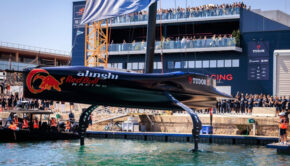America’s Cup: New class rule expected by March 2014
Published on February 1st, 2014
American Pete Melvin has come a long way since the first boat he built as a 6-year old, which, unfortunately, would not float.
But he didn’t let that initial setback discourage him. Now a respected and successful sailor, designer and engineer, Melvin has been hired by the Defender and Challenger of Record of the 35th America’s Cup and tasked with coming up with the class rule for a second consecutive time.
“The process is to listen to the requests and desires of the Defender and Challenger of Record, which includes reducing the costs of the boats and in fact of the entire campaign. On the boat side, that means smaller boats, with less crew, and less personnel involved in design, logistics, and reduced construction costs,” Melvin says.
“We are looking at concepts that are similar to the AC72 – a foiling cat with wingsail. The consensus from teams is that this was a good concept and we want a smaller version in the 60 to 65 foot range. We’re looking at various ratios of beam to length and wing size and power and running VPPs on those boats to see performance, speed, controllability etc.
“We’ll get all the numbers together and then we’ll work with the teams to get consensus on what the new configuration should be from among a few options and then we’ll write the Class Rule around that exact configuration.”
Melvin says he’s getting a broad range of support and help from teams and other stakeholders.
“We’ve already started to re-write the rule. We’ve had a lot of input from the different teams around things like safety, size and cost that they would like to see. And the measurement committee from the last Cup has given input on the way the rule should be written to make it easer to measure and administrate.”
For the 34th America’s Cup, Melvin’s design firm, Morrelli & Melvin, were the lead designers in writing the America’s Cup Class Rule, the first time a multihull class rule had been established for the Cup.
“Last time was a whirlwind as we had concepts but there was also a monohull proposal and both rules were being developed at the same time,” he says. “This time, we have a better idea of what’s involved in the process of developing a concept into a class rule, but we have a shorter time window. So we’re under pressure to be efficient and quick.
“We’ve had good support from most teams and good feedback on items like safety. Three or four of the teams are giving us technical help with creating concepts and running VPPs and it’s good to have that broad base of involvement.”
The input is welcome, especially with the focus on reducing costs. In addition to making the boats smaller than the AC72s used last time, there is talk of making some aspects of the boat one-design.
“We believe significant cost reductions could come from making some items one-design. We’re looking at making parts of the wing one design, so that the teams could share tooling, for example. There are other areas where that one-design concept could work as well,” he says.
“The America’s Cup has always had a large emphasis on design technology and there’s no desire to change that. But there is a desire to reduce the costs of design and construction. So there are areas where it’s interesting to allow design innovation and there are others where you can throw a lot of design resource at something but won’t see a lot of performance differentiation. So those might be areas where one-design makes sense.”
Following their job writing the rule last time around, Morrelli and Melvin went on to work with Emirates Team New Zealand, joining a design team that came within one race of winning the America’s Cup this past September. Melvin hopes to make a similar transition to a team this time.
“It’s not a major focus right now, we have a lot of work to do to get this rule out, but it would be great to end up with a team again,” Melvin says.
“We started our business back in 1992 and our passion was racing multihulls (Melvin represented the USA at the Olympic Games in mulithulls as is a two-time A-Class World Champion) we had to diversify into cruising boats and powerboats just to stay in business.
“We never thought the America’s Cup would come our way and then it did with the 2010 Cup. We wanted to get involved to benefit from the technology that we knew would come out of that. So these last few years have been a dream come true in many ways and we’re happy to be involved.”
The Class Rule for the 35th America’s Cup is expected to be released in March, 2014.
Source: Event website









 We’ll keep your information safe.
We’ll keep your information safe.